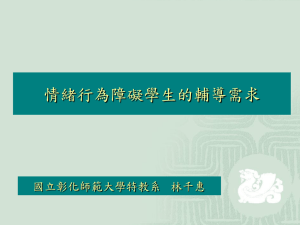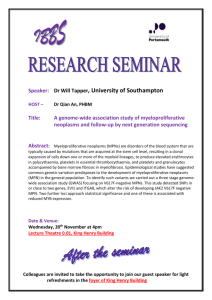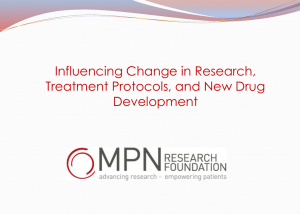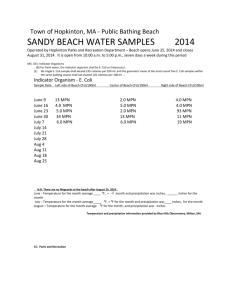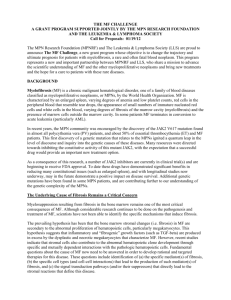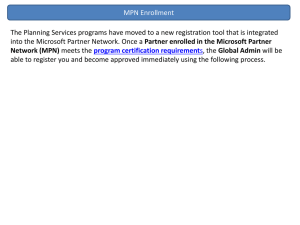mpd new investigator awards - Leukemia & Lymphoma Society
advertisement
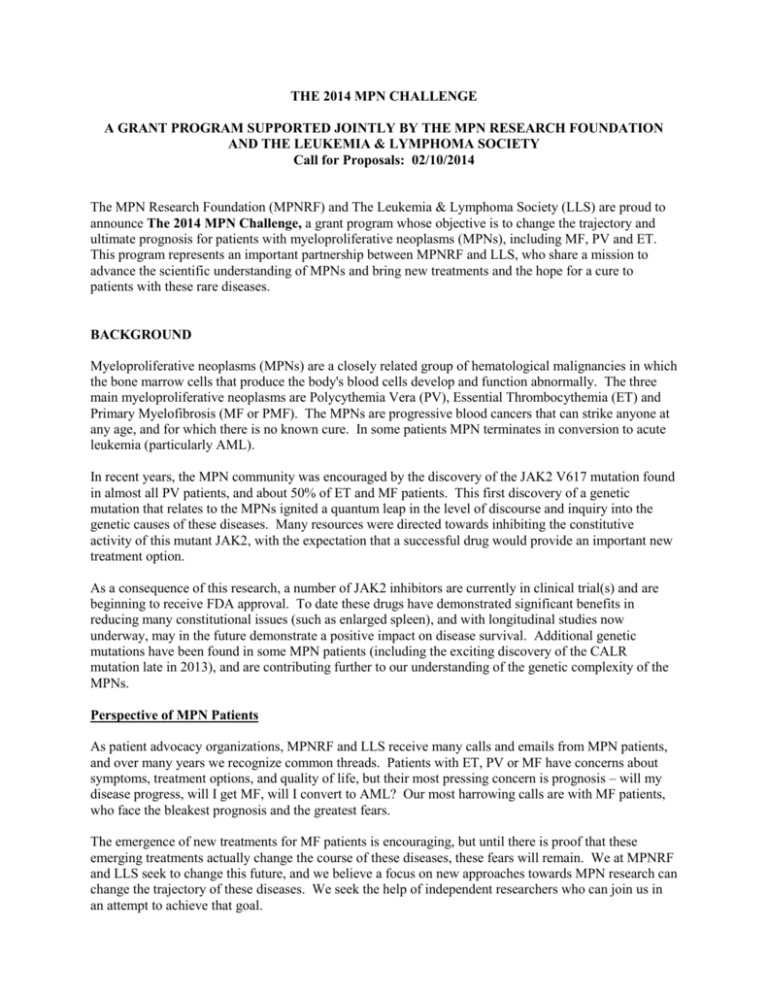
THE 2014 MPN CHALLENGE A GRANT PROGRAM SUPPORTED JOINTLY BY THE MPN RESEARCH FOUNDATION AND THE LEUKEMIA & LYMPHOMA SOCIETY Call for Proposals: 02/10/2014 The MPN Research Foundation (MPNRF) and The Leukemia & Lymphoma Society (LLS) are proud to announce The 2014 MPN Challenge, a grant program whose objective is to change the trajectory and ultimate prognosis for patients with myeloproliferative neoplasms (MPNs), including MF, PV and ET. This program represents an important partnership between MPNRF and LLS, who share a mission to advance the scientific understanding of MPNs and bring new treatments and the hope for a cure to patients with these rare diseases. BACKGROUND Myeloproliferative neoplasms (MPNs) are a closely related group of hematological malignancies in which the bone marrow cells that produce the body's blood cells develop and function abnormally. The three main myeloproliferative neoplasms are Polycythemia Vera (PV), Essential Thrombocythemia (ET) and Primary Myelofibrosis (MF or PMF). The MPNs are progressive blood cancers that can strike anyone at any age, and for which there is no known cure. In some patients MPN terminates in conversion to acute leukemia (particularly AML). In recent years, the MPN community was encouraged by the discovery of the JAK2 V617 mutation found in almost all PV patients, and about 50% of ET and MF patients. This first discovery of a genetic mutation that relates to the MPNs ignited a quantum leap in the level of discourse and inquiry into the genetic causes of these diseases. Many resources were directed towards inhibiting the constitutive activity of this mutant JAK2, with the expectation that a successful drug would provide an important new treatment option. As a consequence of this research, a number of JAK2 inhibitors are currently in clinical trial(s) and are beginning to receive FDA approval. To date these drugs have demonstrated significant benefits in reducing many constitutional issues (such as enlarged spleen), and with longitudinal studies now underway, may in the future demonstrate a positive impact on disease survival. Additional genetic mutations have been found in some MPN patients (including the exciting discovery of the CALR mutation late in 2013), and are contributing further to our understanding of the genetic complexity of the MPNs. Perspective of MPN Patients As patient advocacy organizations, MPNRF and LLS receive many calls and emails from MPN patients, and over many years we recognize common threads. Patients with ET, PV or MF have concerns about symptoms, treatment options, and quality of life, but their most pressing concern is prognosis – will my disease progress, will I get MF, will I convert to AML? Our most harrowing calls are with MF patients, who face the bleakest prognosis and the greatest fears. The emergence of new treatments for MF patients is encouraging, but until there is proof that these emerging treatments actually change the course of these diseases, these fears will remain. We at MPNRF and LLS seek to change this future, and we believe a focus on new approaches towards MPN research can change the trajectory of these diseases. We seek the help of independent researchers who can join us in an attempt to achieve that goal. History of MF/MPN Challenge to Date In 2011 the MPN Research Foundation and the Leukemia & Lymphoma Society initiated the MF Challenge, a grant program focused on the cause and potential elimination of bone marrow fibrosis in MF patients. We began this program because in spite of the current level of activity in MPN research, there were important questions that remained unanswered, and the most urgent were those associated with MF, the most virulent of the MPNs. In 2012 and 2013 the MF Challenge awarded 8 Concept Grants aimed at bringing new ideas, approaches, and investigators to the subject of bone marrow fibrosis. To date, the results are encouraging, and we will continue to seek new approaches in this area until outstanding questions are resolved. However, with increasing numbers of researchers focusing on fibrosis and potential combination therapy, we recognize the need to expand the MF Challenge to other unanswered questions in MPN research. Therefore, in 2014 we are renaming our program The 2014 MPN Challenge, and while we continue to solicit proposals on fibrosis, we are also looking for applications in other critical areas related to all of the MPNs. THE 2014 MPN CHALLENGE The goal of the 2014 MPN Challenge is to continue to search for the factor(s) that induce(s) fibrosis in bone marrow, and in addition to identify new avenues of research which will strengthen the overall understanding of the cause(s) and potential treatments for all of the MPNs (ET, PV and MF). We also encourage investigators in other fields whose research may have cross-over appeal to the MNP research community. Why this Approach is Appropriate Now Based on the response to MF Challenge RFPs in 2012 and 2013, MPNRF and LLS are encouraged to believe that ‘paradigm-shifting’ strategies can be identified in many areas of cancer and basic biology research which can be brought to bear in the search for MPN treatments. These new strategies, in combination with currently emerging treatments, could truly change the course of these diseases. Grants to Stimulate New Avenues of Research MPNRF and LLS believe that the best way to encourage innovative research on MPNs is to encourage new ideas and potentially new researchers. We therefore propose to solicit proposals designed to allow initial exploration of untested but potentially transformative research ideas and approaches. In order to receive such a grant, applicants must describe an innovative idea or approach and a method for testing that idea/approach. Depending on the response to this RFP (i.e., if multiple proposals of sufficient potential to merit an award are received), we anticipate funding up to 10 awards in calendar year 2014. Term of Grant Grants of $100,000 will be made for an initial one-year term. Near the completion of the one-year period, applicants will be evaluated by our peer review process on the extent to which their proposal has been substantiated by initial testing. Projects which pass this review may be eligible for second-year funding up to an additional $100,000. Focus Areas for 2014 MPN Challenge Grants In November 2013, the MPN Research Foundation convened a group of scientists from both academia and industry to discuss the unmet needs in MF and MPN research, as a guide for future grant programs. This diverse group of current MPN Challenge grantees, academic scientists and representatives of companies currently involved in MPN treatment development held a lively interchange which resulted in the following list of focus areas for the 2014 MPN Challenge: 1. Fibrosis and the Bone Marrow Niche. New or continued effort to discover the factor(s) that induce(s) fibrosis of the bone marrow, and to identify opportunities to arrest and reverse this fibrosis. Of particular interest are the interactions between the MPN stem cell and the bone marrow/microenvironment niche which contributes to fibrosis, extramedullary hematopoiesis, or MPN cell survival. Areas of interest/relevance include but are not limited to the following: Myelofibrosis caused by abnormal megakaryopoiesis and platelet production, including abnormal growth factor release Myelofibrosis caused by inflammation; role of cytokines Myelofibrosis caused by disordered extracellular matrix formation Myelofibrosis caused by a defective stem cell niche Other models of fibrotic diseases with potential relevance to myelofibrosis: e.g., pulmonary fibrosis, renal interstitial fibrosis, systemic sclerosis (scleroderma), progressive systemic sclerosis Cancer-initiating cells in myelofibrosis Anti-fibrotic agents/anti-fibrotic therapy Biomarkers (genomic, proteomic, or other) which predict the development of myelofibrosis 2. CALR Mutation. The recent discovery of the Calreticulin gene (CALR) exon 9 mutations in the majority of JAK2-negative patients with chronic MPNs opens new avenues for translational research. In addition to its potential for new druggable targets, basic understanding of the mechanisms and consequences of CALR mutations in MPNs will be needed to develop novel rational therapeutic agents for these disorders. As an ER chaperone, mutant calreticulin might play critical roles in survival and proliferation of MPN stem cells, creating an abnormal microenvironment, aberrant angiogenesis, or abnormal ER stress response in activation of the unfolded protein response that is normally needed for stress-induced autophagy. Studies along these lines may elucidate basic mechanisms of MPNs and their complications, providing new treatment strategies. 3. Reducing MPN Allele Burden. In a subset of MPN patients, interferon has shown the ability to reduce the mutant allele burden, be it JAK2 V617F or other disease alleles which mark the disease clone. Recent studies have suggested that other agents might have anti-clonal effects in a subset of patients, which have the potential to indicate disease modifying activity. We solicit proposals that can identify the mechanism(s) of action of agents with possible anti-clonal activity, including interferon, telomerase inhibitors, or other agents which have shown preliminary evidence of molecular response in the clinical setting. 4. Selective JAK2 inhibition. Development of a strategy for selectively targeting the mutant JAK2 protein to reduce toxicities associated with inhibiting wild-type JAK2. Additionally, approaches to target pathways downstream of JAK2 are sought. 5. Immunotherapy. Basic research to investigate the potential for control of marrow fibrosis and suppression of aberrant MF clones by immunotherapy or immune manipulation. It is well understood that immunotherapeutic approaches have clinical therapeutic value it at least a subset of MPNs. CML and other MPNs, for example, can be effectively treated with interferon, and in some cases of CML, cures are possible using adoptive T-cell transplantation. We solicit proposals for immunotherapeutic approaches to the broader spectrum of MPNs that could include, but is not limited to: assessment of the potential role of chimeric antigen receptor therapy therapy targeted to inflammatory cytokines and/or cytokine receptors and their downstream effectors exploration of the role of immune checkpoint regulators in MPNs, e.g., CTLA-4, PD-1, PD-L an understanding of how to combine any of these with evolving standard of care therapies for MPN and in particular, since newly approved agents such as pan-JAK inhibitors have potential to impair immune cell activation and function, how or should they be used with immunomodulatory agents is an important question Proposals submitted may focus on preclinical or clinical approaches to immunotherapy but proposals that have clear translational potential will be prioritized. Criteria for Evaluation Proposals will be evaluated against the following criteria: Relevance to Primary Objective. (see description of Focus Areas above) Innovation. We favor proposals designed to allow initial exploration of new ideas with the potential to open new avenues of investigation. MPN Challenge grants are generally NOT intended to support the logical progression of an already established research project, though research that, if successful, ultimately leads to breakthroughs in the diagnosis or treatment of patients with MPNs will be reviewed favorably. Preliminary data are not required to support your scientific rationale. Research Strategy and Feasibility. Does the scientific rationale logically support the project and its feasibility? Are the aims, experimental design, methods, and analyses well developed and integrated into the project? Does the PI acknowledge potential problems and pitfalls? Is it a reasonable expectation that the studies will yield meaningful results in a one-year period of time? Collaboration. Proposals that engage interdisciplinary teams and approaches may receive favorable attention, as will proposals made by collaborative teams, either within or across research institutions. Proposal reviewers will also be directed to identify opportunities to repurpose existing resources (e.g., mouse models, other tools) rather than re-invent them; proposals that have already identified such collaborative possibilities will be reviewed favorably. Commitment to Information Sharing: MPNRF and LLS believe that sharing data is critical for advancing the science as rapidly as possible. While understanding the confidential nature of the research process, it is our expectation that all data will be made public within a year of being generated. We encourage scientific papers, presentations at ASH or comparable venues, smaller meetings, and website publication. Key Dates Call for proposals Proposal due date Scientific Peer Review Committee Notification of Awards Anticipated funding start date February 2014 April 1, 2014 May 30, 2014 (final review) July 1, 2014 October 1, 2014 Provisions Related to Intellectual Property The MPN Research Foundation and The Leukemia & Lymphoma Society are committed to moving the results of basic and translational research to MPN patients. To that end, we include in our contracts with the institutions of our awardees Intellectual Property language meant to ensure that no critical results are left without productive follow-up. We ask that you review this language (which is attached to this email) with your grant/contract office and forward any questions to Allison Formal (Allison.formal@lls.org). This will greatly facilitate the contracting process following the award and help ensure grant payments begin as quickly as possible. Application Process Applicants should prepare a grant application following the format described below and email this full proposal to the MPN Research Foundation no later than April 1, 2014. Please title the PDF or Word file as follows: Last Name(space)First Name(space)2014. The proposal should be emailed to the attention of Michelle Woehrle at mwoehrle@mpnresearchfoundation.org. 2014 MPN CHALLENGE GRANT PROPOSAL Cover Sheet Investigator Summary* Investigator(s): Investigator Title(s): Investigator Position(s): E-mail address(es): Department(s)/Division(s)/Institution(s) or Company: Address(es): Phone Number(s): Biographical Summary & relevant Published Work: (brief CV (max 5 pages) may be attached; do not attach longer CV, although a link may be provided) *If there are co-principal investigators, please include identifying information for each 2014 MPN CHALLENGE GRANT PROPOSAL Project Description Project Summary Institution/Company(s) where work will be done: Project Title: Focus Area(s) Addressed by Project (check all that apply): FOCUS AREAS yes/no Fibrosis and the Bone Marrow Niche CALR Mutation Reducing the MPN Allele Burden Selective JAK2 Inhibition Immunotherapy Project Abstract (200 words or less): Project Description Project Description should be no more than three to five pages, single spaced, font size no smaller than 11; the 5 page limit should include any figures and tables. Specific Aims (please list) Scientific rationale/Previous Work (upon which this project will be based) Research Plan/Anticipated results Innovation statement Resources and Environment Plans for Investigator Interaction Human and/or Animal Investigation Statement (description of any IRB approval/status required for this project) should be appended but is not part of the 5 page limit on Project Description. 2014 MPN CHALLENGE GRANT PROPOSAL Budget Information Budget Proposals may request up to the full amount of the grant including up to 8% indirect costs. Awards are anticipated to be up to $100,000 for a one-year grant period. Personnel: Name Role on Project % Salary PERSONNEL TOTAL Fringe Amt. Salary Total $xxx,xxx Budget Summary: Category Amount Personnel Total (from table above) Consultant costs Equipment Supplies (itemize by category in budget justification) Procedures/labs Patient care General services Travel Other expenses TOTAL COST $xxx,xxx Budget Justification: (if appropriate to further describe costs above; please limit justification to a maximum of one page)
